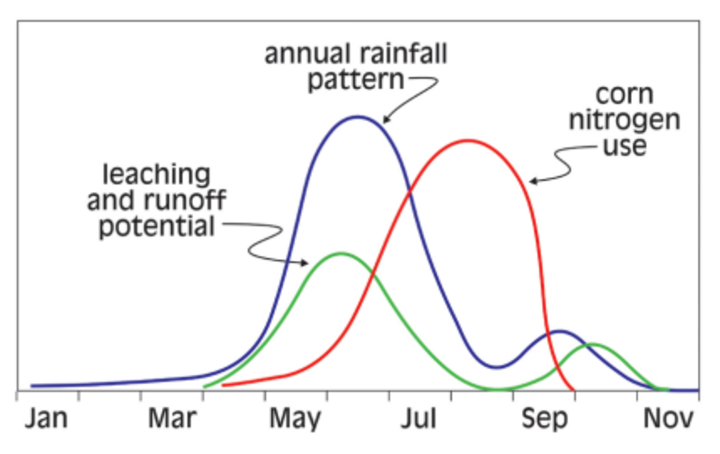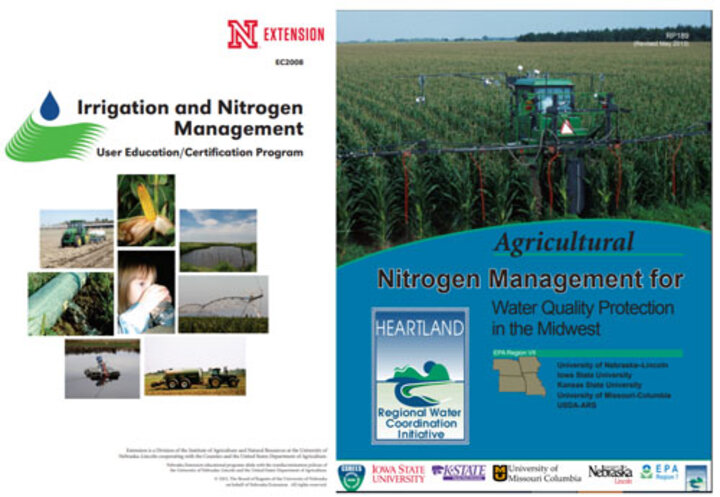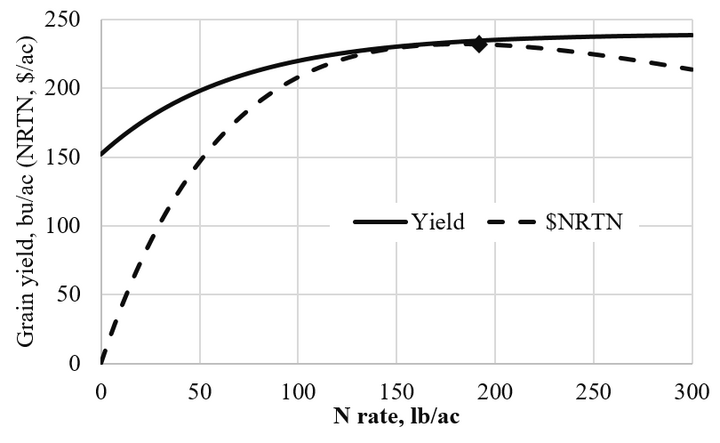The leaching of nitrate to groundwater and the increasing occurrence of groundwater with excessive nitrate levels for human consumption are of major concern in Nebraska. The amount of leached NO3- depends on soil NO3- concentration at different soil depth layers and the quantity of water movement downward through these soil layers to beyond the root zone. Nitrate-N leaching is not like flushing a toilet! It is a gradual downward movement with adjustments in the nitrate concentration of soil water as it percolates through many soil layers. Most leaching is expected to occur from late April to June (Figure 1). This article provides a practical condensation of information from numerous research works and Extension publications to offer management options for reduced leaching loss of nitrate (NO3-) to the vadose zone and eventually to the aquifer (Figure 2). Nine agronomic management opportunities for reduced NO3- leaching are addressed, most with little or no cost and often with reduced ammonia volatilization and nitrous oxide (N2O) emission to the atmosphere.


Avoid excessive water
A full-season fully irrigated corn crop uses about 26” of water including stored soil water, rainfall and irrigation water. More water may be required if significant losses to soil evaporation and deep percolation occur. Deep percolation in the spring before the crop has a high rate of water use is often unavoidable, especially for sandier soils in Nebraska. While such deep percolation often contributes eventually to aquifer recharge, it also carries NO3- to groundwater. Deep percolation can be reduced by judiciously scheduled irrigation and depletion of soil water as the crop matures to allow for the soil storage of precipitation. Soil NO3- concentrations can be reduced by practices addressed below.
Cropping system
Previous crop
Fertilizer-N recovery (defined as the increase in pounds of N uptake by the above-ground crop per pound of fertilizer-N applied) is greater for the corn-soybean rotation than for continuous corn. The greater recovery with the rotation is due to better N recovery efficiency by corn with soybean rather than corn as the previous crop, but also because soybean on average gets about 55-70% of its plant N from the biological fixation of atmospheric N and effectively scavenges soil inorganic N to meet the balance of N need.
The average amount of grain-N removed in harvest for Nebraska is about 0.7 lb/lb of fertilizer-N applied for continuous corn but near 1.0 lb/lb for the corn-soybean rotation. The amount of N applied with the corn-soybean rotation is about 40% of that applied with continuous corn. The greater recovery efficiency and the greatly reduced fertilizer-N applied is expected to reduce NO3-1 loading of the vadose zone (the depth from the rooting zone to the top of the water saturate aquifer) and movement to groundwater. In a 20-year study in Nebraska, nitrate accumulated to 60 foot depth was 28% less with the corn-soybean rotation compared with continuous corn but this was an underestimate due to over-irrigation of soybean and over-application of N to corn following soybean; a 40-50% reduction in NO3- leaching is more likely.
Alfalfa in rotation
The value of alfalfa in rotation with annual crops for reducing NO3- leaching loss has been recognized for decades. In addition to alfalfa uptake of inorganic N to about 10-12 foot depth and using NO3- applied in irrigation water, the fertilizer-N required for such a rotation with alfalfa is about 45% of that required by the corn-soybean rotation. The profitability of having 5 years of alfalfa rotated with 5 years of corn-soybean rotation may be greater than with corn-soybean rotation. In Iowa, having alfalfa in the rotation for 50% of the years is credited with 42% less nitrate loss to tile drainage compared with the corn-soybean rotation. Alfalfa in the rotation appears to be especially worthy of consideration for community well-head protection areas.
Double cropping
Producing a cover crop or an annual forage crop, whether grazed or cut for harvest, increases residual inorganic N uptake relative to the growth achieved. The N uptake may be 25-30 lb per 1000 lb of dry matter, depending on growth stage and species. The uptake will be primarily from the 0-12 in depth while deeper nitrate is most prone to leaching below the rooting depth of the primary crop. The plant N will not be fully available to the following primary crop; some proportion of cover crop N is likely to be available for later growth of the primary crop with additional plant N mineralized after N uptake by the main crop has ceased. As a result, additional fertilizer N is often needed to maintain yield following such a cover or forage crop. Early immobilization of N is less with legume than with non-legume cover crops due to relatively high N content. For grazed fields, the excreted-N that is not lost to the volatilization of ammonia will soon be available for uptake by crops and soil microbes. The double cropping effects on NO3- accumulation in the vadose are yet to be validated but greater effects are expected as soil sand content increases. Winter rye cover crop is credited in Iowa for reduced NO3- loss in tile drainage.
Nitrification inhibitors and special N-fertilizers
Products that delay the conversion of fertilizer-N to highly mobile NO3- have been available since the 1960s and have been extensively studied. Much information is readily available. Such products, if well-targeted and used in a timely manner, can have a modest role in reduced leaching of NO3- from fertilizer-N, but not from residual soil NO3-, with sandy loam or sandier soil. The greatest NO3- leaching potential for most fields in Nebraska is in May and early June although the potential is great for sandy soil throughout the year. The use of nitrification inhibitors or N fertilizer products needs to be timed to minimize nitrification of fertilizer-N before and during the time of high leaching potential such as with application in April to June. The use of nitrification inhibitors was not effective in reducing leaching for a silt loam soil in Nebraska during 20 years of continuous irrigated corn while the application of excessive fertilizer-N had a great effect (Figure 3). The results indicate little potential for use of nitrification inhibitors to reduce NO3- leaching to the vadose for silt loam, silty clay loam and finer texture soils, likely due to relatively little water percolating below the root zone compared with sandier soils. Use of a nitrification inhibitor with late fall-applied anhydrous ammonia may reduce NO3- leaching to the vadose, especially if the field has some sandy loam or sandy soil, and have resulted in some yield increases for eastern Corn Belt states. Use of an inhibitor with fall applied anhydrous ammonia is credited with a 7% reduction in nitrate loss to tile drainage in Iowa, while inhibitor use with spring application is not part of their strategy. The loss of nitrate to tile drainage in Iowa was 6% greater with fall compared with spring N application and 4% less with in-season application compared with pre-plant application. Some reduction in NO3- leaching is expected in Nebraska with inhibitor use for fertilizer-N applied to sandy loam or sandier soil in the spring before June 1. Overall, nitrification inhibitor use should be well-targeted and only a small part of strategies to reduce NO3-1 leaching.

Manure nitrogen
Organic N applied annually to Nebraska cropland is equal to 150 lb/ac fertilizer N applied to about 1.3 to 1.6 million acres. Organic N availability from land-applied manure and other organic materials is not well predicted. The UNL recommendations for manure N availability are conservatively low to protect against yield loss but are too low for minimized leaching of NO3-. For example, a total of 47% of the organic N in beef feedlot manure is currently credited during the three years following application while the actual average credit is about 75%. If groundwater quality protection is of high priority, an even greater credit should be given. Crop need for additional in-season N application can be assessed for manured fields using remote sensing of canopy reflectance for high N use efficiency. With sensor guided in-season N application for manured fields, pre-plant fertilizer N should not exceed 60 lb/ac to allow for uptake of manure N while allowing sufficient deficiency for the need for additional N to be indicated by the canopy reflectance.
Avoid excessive N application
The fertilizer N rate
The fertilizer-N rate has a great effect on the leaching of NO3-. When N rate was increased from 134 lb/ac/yr (150 kg/ha/yr) to 268 lb/ac/yr (300 kg/ha/yr), the equivalent of about 20% of the additional 134 lb/ac/yr accumulated in the vadose zone to 30 ft depth after 20 years of irrigated continuous corn on a silt loam soil (Figure 3). Likely, more NO3- accumulated below the 30 ft depth so that loss of the second rate increment of 134 lb/ac/yr was likely >25% for N in excess of 200 lb/ac. This loss likely would have been greater with sandy loam or sandier soil unless most of the fertilizer-N was applied in-season in response to the estimated crop N need.
Crop yield response to N rates is curved with yield increases diminishing to zero as N rate increases as illustrated for an estimated mean response to N for irrigated corn following corn in Nebraska (Figure 4). The value of yield gains is less than the cost of fertilizer-N use once the most profitable N rate (economically optimal N rate, EONR) is exceeded. Therefore the efficiency of fertilizer-N recovery decreases with increased fertilizer-N rates. Based on high-yield corn responses to fertilizer-N across Nebraska, the mean recovery efficiencies for corn following corn for N rate increments of 50 lb/ac were 53% for 100 to 150 lb/ac N, 38% for 150 to 200 lb/ac N, and 24% for 200 to 250 lb/ac N. Similarly the recovery efficiencies for corn following soybean for N rate increments of 50 lb/ac were 74% for 50 to 100 lb/ac N; 51% for 100 to 150 lb/ac N; and 28% for 150 to 200 lb/ac N.

The average EONR for irrigated corn statewide for sandy loam or sandier soils is about 220 lb/ac for corn following corn and 174 lb/ac N for corn following soybean with
- a yield goal of 220 bu/ac (determined from the State average irrigated corn yield),
- $700/t for anhydrous ammonia (purchase plus application cost),
- $350/t for 32% UAN,
- 2.0% soil organic matter,
- 10 ppm NO3-N in irrigation water with 10 inches applied, and
- with 60% of fertilizer-N applied in-season
While fertilizer-N recovery has nearly doubled since the sixties due to greatly increased yields without much increase in fertilizer N applied, mean N rates of producers may be 20-30 lb/ac more than EONR. This excess fertilizer N has an average recovery efficiency of only 24% for corn after corn and 28% for corn after soybean, likely with a high percentage of the excess N lost to leaching of NO3-.
UNL N algorithm and calculated EONR
The UNL N rate algorithm has been repeatedly validated for accurate estimation of average EONR for both sandy and non-sandy soils. However, there is much deviation of the actual from the mean EONR associated with climatic and growing situation variations. This variation cannot be accounted for in pre-season estimates of N need. Therefore, UNL has long recommended that a significant amount of fertilizer-N be applied in-season according to crop condition to better determine EONR and to reduce NO3- leaching. This is especially true for sandy loam or sandier soils for which fertilizer-N applied before June 1 should be ≤75 lb/ac N for corn. In the early 1990s to early 2000s, the use of pre-sidedress (or late season) NO3--N soil tests or chlorophyll meters were recommended for determination of in-season N application rates. More recently, remote sensing of canopy reflection is used to determine in-season N rates. The Maize N model is an alternative or complementary to remote sensing for determining in-season N rates, including for fertigation decisions. The in-season application may be with uniform or variable rates depending on the variation in crop N need.
Multiple benefits of N rate reductions
Nitrogen losses due to leaching, volatilization, denitrification and N2O emission are associated with N rate. Therefore, a reduction in fertilizer-N rate can have multiple benefits (https://cropwatch.unl.edu/2019/effects-reduced-n-rate-corn-profitability-and- nitrogen-losses). In Table 1, fertilizer-N rate reductions are addressed for decreased leaching of NO3- and for decreased N2O plus carbon dioxide equivalent (CO2e) emission. Because the N rate reductions from EONR are at N rates where decreased fertilizer-N has little effect on yield, the reductions in NO3- leaching and N2O (and CO2e) emission can be achieved at a low cost. The cost of reducing NO3- leaching with fertilizer-N reductions of up to 50 lb/ac varies from $0.29 to 0.69/lb of leached nitrate-N (1.1 to 2.6% reduction in net return to fertilizer-N) for corn after corn and $0.53 to 1.18/lb N of leached nitrate-N (1.7 to 4.1% reduction in net return to fertilizer-N) for corn after soybean. Similarly, estimated costs per ton of reduced CO2e emission due to fertilizer-N reductions of up to 50 lb/ac varies from $19.72 to 47.45/t CO2e for corn after corn and $14.48 to 32.62/t CO2e for corn after soybean. In comparison, estimated costs for CO2 capture at coal-burning plants and its transport and indefinitely long-term storage total from >$50 to 200/t. When fertilizer-N use is above EONR, reductions in leached N and CO2e emission can be achieved at no cost.
| Previous crop | Corn | Soybean | ||
|---|---|---|---|---|
| N rate reduction for EONR, lb/ac | 25 | 50 | 25 | 50 |
| Yield change, bu/ac | -2.46 | -6.17 | -2.36 | -5.55 |
| NRTN† change, $/ac | -1.43 | -6.88 | -1.05 | -4.73 |
| NRTN change, % | -1.06 | -2.65 | -1.74 | -4.1 |
| Leached NO3-N decrease, lb/ac | -5 | -10 | -2 | -4 |
| Cost of NO3-N reduction, $/lb‡ | 0.29 | 0.69 | 0.53 | 1.18 |
| CO2e emission decrease, lb/ac | -188 | -375 | -188 | -375 |
| Cost of CO2e reduction, $/t | 15.25 | 36.69 | 11.2 | 25.23 |
† NRTN, net returns to fertilizer N applied.
‡ The cost of reductions were estimated for reductions in NO3-N leached or CO2e emission individually without attributing the other reduction.
Summary
There is much opportunity to reduce NO3- leaching to aquifers at modest or no cost while reducing ammonia volatilization and CO2e emission through use of one or more of the following nine practices.
- Irrigation for maximized net returns and soil storage of water from precipitation.
- Reduced frequency of corn following corn, which is much less N-use efficient than the corn-soybean rotation.
- Alfalfa in rotations, such as 5 years in a 10-yr rotation with annual crops, especially for community wellhead protection areas.
- Double cropping with a cover or forage crop following the main crop, especially where much residual soil NO3- is expected and soil water depletion is not likely to constrain the following primary crop.
- Use of nitrification inhibitors or specialty N-fertilizer products for sandy loam or sandier soils timed for reduced leaching from April to June.
- Adequately crediting N supply from manure or other land-applied organic materials coupled with in-season fertilizer N application guided by crop canopy reflectance.
- Nitrogen application at EONR.
- Nitrogen application at less than EONR with a small cost such as 1.4% reduction in net returns to fertilizer-N with 25 lb/ac less than EONR and 3.4% reduction in net returns to fertilizer-N with 50 lb/ac less than EONR.
- In-season N application, especially for sandy loam or sandier soils, guided by crop canopy reflectance and/or model simulation.
